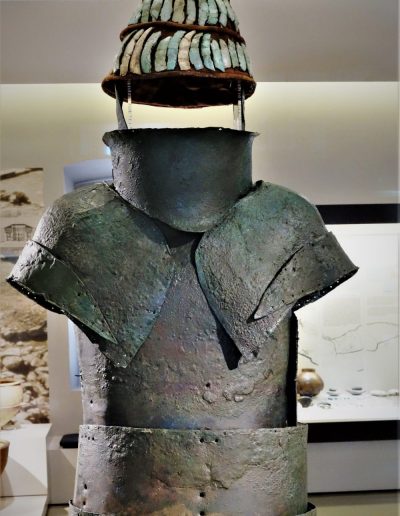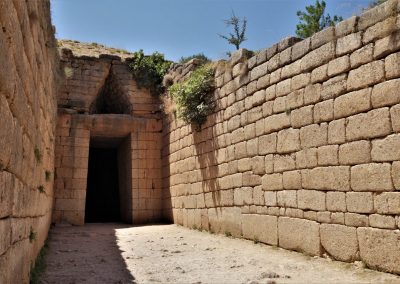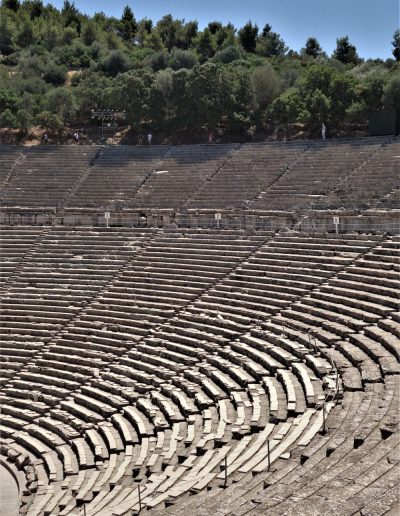- We parked ourselves in Nafplio for the last week of the trip. It’s a lovely city at the northern end of the Argolic Gulf and is dominated by its fortresses.
- The Akronafplia Fortress is the oldest, dating back to the Bronze Age and rises up directly behind the city. The Palamidi Fortress sits in a commanding position high above the city. It was built by the Venetians between 1711 and 1714. The small, island fortress of Bourtzi was built in 1473 (also by the Venetians) and it’s a pleasant round trip by excursion boat to walk its walls and admire the views back to the city.
- Nafplio also has good museums, with the Archaeological Museum being a highlight, and decent beaches in walking distance.
- The other reason we chose to stay in Nafplio is that it’s a great base to explore the incredible archaeological heritage in this region. We visited the great Mycenaen cities of Mycenae and Tiryns, the amazing theatre and sanctuary of Epidavros, and the ancient city of Argos.
- We had a fantastic time in Nafplio and would gladly return.
- From here we drove back to Athens airport, dropped the hire car, and flew home.
- Our hotel was in the old part of Nafplio, nestled into the base of the Akronafplia Fortress. We could walk to Arvanitia Beach. And with a bit of huffing and puffing could walk the supposed 999 steps to Palamidi Fortress.
- The ancient city of Mycenae is a World Heritage archaeological site. It was the principal city of Mycenaean civilization which dominated the eastern Mediterranean world from 1600 to 1200 BC. In Greek mythology it was the home of Agamemnon and it features in Homer‘s epics poems, the Iliad and the Odyssey. The ancient city was excavated in 1876 by a German businessman named Heinrich Schliemann whose methods were controversial.
- The site has incredible walls, said to have been built with the help of a Cyclops, and you enter through the famous Lion Gate. It has tholos tombs, grave circles, the remnants of many houses, and a fascinating cistern in the north east corner. The on-site museum is very good, though many of the more famous finds are in the National Archaeological Museum in Athens. Just outside the main site is the Treasury of Atreus which is an incredible structure. What a day.
- Epidavros is best known for its amazing theatre built in 400 BC, though there’s much more to this World Heritage site. It is the shrine of Asklepios, god of medicine, and the vast site includes temples and hospital buildings devoted to its healing gods, providing insight into the cults of Greek and Roman times. We spent several hours exploring it.
- The town of Ancient Epidavros is further east, on the coast. We checked out its much smaller theatre, had a swim at the ‘sunken city’ beach where you can do some underwater archaeology with a mask and snorkel, then ate a fabulous dinner on a vine covered terrace at a taverna that had been recommended to us by locals.
- We headed back to archaeological site around 21:00 to see the play ‘Helen’ by Euripides performed in the ancient theatre. It was a wonderful experience for us.
- This whole day was just perfect.
- One morning we drove to Argos, which has a history dating back 6,000 years. We visited the Fortress of Larissa which sits high above the city. Then checked out the Roman ruins which include an impressive rock cut theatre that seated 20,000 at its peak, and remnants of the baths. We drove a little further south to see the curious Pyramid of Hellenikon, the best known of the Greek pyramids of the Argolis region. From there we headed east to the coast and had a great lunch at a seafood taverna in the fishing port of Nea Kios.
- Another afternoon we visited Tiryns, which is also a World Heritage site along with Mycenae. Tiryns was the ‘second city’, and its walls are as if not more impressive than those of Mycenae. It’s a much less famous site and it was enjoyable to be able to wander amongst the ancient stones with few other people around.

















































